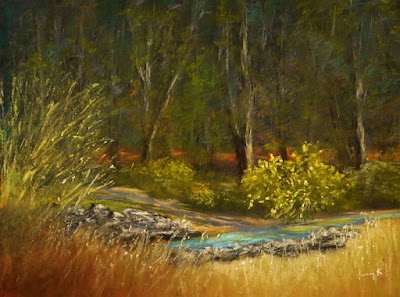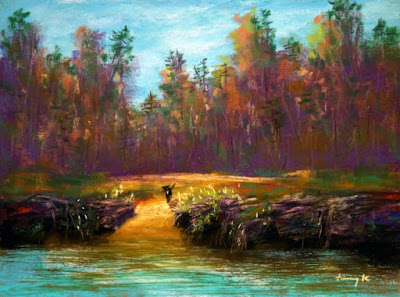So after years of frustration due to the hassles of having to frame soft pastels under glass, and even the occasional challenges of storage to avoid smearing and smudging, I had the good fortune to chat with Andrew at
Savoir-Faire during the annual Art of the Carolinas Expo this month. He mentioned to me that the maker of my favorite pastel workable fixative that I often use to help fix underpainting layers,
SpectraFix, had come out with pastel varnish and suggested I contact the owner about it. I was obviously intrigued since I'd been trying a couple of experiments with varnishing soft pastels but the spray varnishes I'd found so far had such toxic fumes that using them was a headache-inducing nightmare and they also tended to darken and deaden the vibrancy of my pastel works too much for my liking, so I sent a message to Della, the owner of SpectraFix. She very kindly gave me a call and told me all about her newest products, Natural Glass Varnish and FinalFix Spray. I decided to try both these products to see if they lived up to my expectations. Just by way of information, I use a variety of pastel brands, but primarily in the medium-soft to very-soft textures, and while I may not have the lightest hand in the world, I do have a fairly gentle application touch for the most part.
For my first experiment, I pulled out two small test works, one on Multimedia Artboard sanded pastel panel and the other on Richeson Premium sanded pastel paper. I sprayed one thin coat of FinalFix on each and allowed it to dry. SpectraFix products have no toxic fumes (yay!), so using them indoors is no issue, even with a cat and dog in the house. It didn't take long for the first coat to dry, and I then applied a heavier second coat on the Artboard and very lightly brushed a coat of the Natural Glass on the Richeson. Of note, since the Natural Glass varnish is slightly thick it ideally should be brushed on rather than sprayed (I found it tended to clog a pump sprayer), and the painting surface does need a coat of either SpectraFix Degas fixative or FinalFix prior to applying Natural Glass. The varnish should be brushed on very lightly even then to avoid disturbing the pastels. Of note, the Natural Glass varnish leaves a somewhat glossy appearance more like paint, whereas FinalFix maintains the smooth velvety matte appearance of traditional soft pastels.
As Della had mentioned on the phone, there was some slight deepening or perhaps very minimal darkening of the colors on both paintings, although I wouldn't call it deadening, and the vibrant sections retained their vibrancy. The surfaces had no shift or movement of the pastels when touched after allowing the SpectraFix to fully dry.
 |
"Carrying the Sky on His Back"
© 2019 Tammy Kaufman
7" x 5" soft pastel on Pastelbord
|
Satisfied with these results, I pulled out a painting on Pastelbord and two others on standard gesso panels on cradled wood. I used the FinalFix spray on all three and let them dry. I applied a second coat on the Pastelbord and one of the panels and brushed Natural Glass on the second panel. I noticed similar results on these as on the sanded papers - slight deepening of the colors, but no terribly significant color change once fully dry. Again, the surfaces with only FinalFix retained the velvety matte finish for which soft pastel works are known and the surface with Natural Glass turned slightly glossy and paint-like, but all the surfaces were now completely touchable with no smudging or smearing at all, and virtually no pastel coming off on my hands. I achieved more or less the same results using FinalFix on Pastel Premier, Canson Touch, UArt and Pastelmat. Unsanded pastel paper has so far yielded similar results, but as expected with plain paper surfaces, it does take a while to dry and there was some minimal buckling which was not unexpected.
 |
"Cascading Rhyme and Rhythm"
© 2019 Tammy Kaufman
4" x 4" soft pastel on Da Vinci Pro Resist-Grip Coarse Textured Cradled Gesso Panel
Inspired by South Mountains State Park
|
On a lark, I decided to test out the FinalFix on Sennelier La Carte Pastel Card, which is notoriously intolerant of water and also responded very poorly to the toxic varnish sprays I had previously tried. This product worked reasonably well on that surface, although I did find the colors darkened on La Carte a bit more than the other sanded surfaces I've tried so far, but in fairness I used the darker toned paper. Also, be sure you let the spray dry completely before touching this paper.
Repeat - do not touch La Carte until the FinalFix spray is completely dry! (Ask me how I know this...)
 |
"Gossamer Melody Haunting"
© 2019 Tammy Kaufman
Cropped section of 5" x 7" soft pastel on Sennelier La Carte Pastel Card
|
FINAL IMPRESSIONS: Overall, I'm quite impressed with these new SpectraFix varnishes so far, especially since I tend toward painting on stand-alone surfaces such as cradled blocks which present their own unique challenges with framing under glass, and these new products are a potential game-changer for me. Also my specialty is miniatures, so with such a small surface area I have not noticed any real issues with spatter which could possibly be a concern on larger works. For me, the slight deepening of color is outweighed by the benefits of more framing and display options. However, every artist is different and your priorities and acceptable outcomes may differ from mine, so I highly recommend testing these or any products on paintings that you don't mind ruining, just in case. Also, while there did appear to be significant darkening while the finishes were wet, in my experience the colors mostly restored once fully dry, and I found that the harder and/or grittier surfaces did somewhat better and the more absorbent/softer/smoother ones a little less so and with a little more darkening of color, though not significantly enough to outweigh the benefits for me personally. So I will likely be using this product for my cradled wood paintings for sure and probably also for some works on paper or boards that I want to frame sans glass, but I want to explore more experimental opportunities before I feel totally confident using it on my most precious works.
NOTE: The rules for some juried pastel shows prohibit the use of final fixatives so artists entering these competitions will need to keep that in mind and check the rules carefully before entering if they choose to use these varnishes.
































